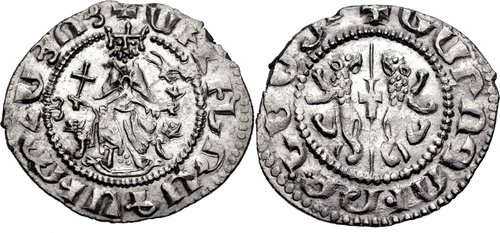Death of Oshin I (July 20, 1320)

At the turn of the fourteenth century, the Armenian kingdom of Cilicia had already begun the most turbulent period of its history, which would lead to its decline and fall decades later.
Oshin, the future king, was born on January 10, 1283. He was the fifteenth child—six of his elder siblings had died at a young age—of King Levon II (1270-1289) and Queen Keran (Kyranna). The relentless offensive of the Mamluks of Egypt started eating away at the territory of Cilicia and the strategic alliance with the Ilkhanate, the Western division of the Mongol Empire, was not enough to stop it. The situation worsened after Mongol ruler Ghazan Khan (1295-1304) converted to Islam.
In 1303, Oshin’s older brother Hetoum II (1289-1293, 1295-1296, 1299-1303) abdicated in favor of his nephew Levon III (1303-1307), who was fourteen years-old, and became regent. Four years later, Mongol general Bilarghu, in charge of the garrison in Cilicia and a devout Muslim, indicated his intention to build a mosque in the capital Sis. Hetoum complained to Öljeitü Khan (1304-1316) in a letter. On November 17, 1307, Bilarghu summoned the regent and the king to his encampment near Anarzaba (Anazarba) and had them assassinated with their retinue.
Oshin immediately marched against Bilarghu and defeated him, forcing him to leave Cilicia. He was crowned king and supported by Öljeitü, who had Bilarghu executed for his crime.
The new king was married to his cousin Zabel of Korikos, with whom he had one son, Levon, born in 1309. In the same year, he ordered the execution of Oshin, Marshal of Cilicia and his wife’s uncle, for the murder of his elder brother, King Toros III, in 1298. Zabel died in 1310.
Oshin’s sister, also called Zabel, had married Amalric of Tyre. When Amalric usurped the government of Cyprus from his brother, King Henry II of Cyprus, the latter was held by Oshin in Cilicia. He was, however, released and returned to Cyprus upon the assassination of Amalric in 1310. After Zabel of Korikos’ death, Oshin married Isabelle of Lusignan, daughter of King Hugh III of Cyprus and widow of Constantine of Neghir, Lord of Partzerpert, but divorced her before 1316. Isabelle died in 1319.
Like his brother Hetoum II, Oshin advocated for the union of the Armenian Apostolic Church and the Roman Catholic Church, which was a precondition to obtain help from Europe, but also a matter of huge popular discontent. In 1316, Pope John XXII demanded from the king to restore the decisions of the council of Sis (1307), which had been declared null and void by the councils of Adana (1308) and Sis (1309), and entailed the adoption of the doctrine and the ritual of the Catholic Church, as well as the recognition of papal sovereignty. The drive for the union was reaffirmed by the council of Adana (1316), but this met again the obstinate resistance of the people and the ecclesiastics of Greater Armenia, only contributing to further divisions, which would weaken the country even more.
Oshin died suddenly on July 20, 1320, in the monastery of Drazark. He was succeeded by his eleven-year-old son Levon IV (1320-1342). It was rumored that the king was poisoned by his cousin and former brother-in-law Oshin of Korikos, who became regent.
